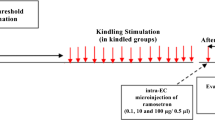Abstract
The effect of atropine on kindling the amygdala of rats was tested by administering the drug in a dose of 25 mg/kg 1 h before each stimulus was applied. Rats tested with atropine kindled at the same rate as saline-treated controls. Cholinergic activity in the amygdala of rats was assessed, 4 weeks after the completion of kindling, by measuring both muscarinic receptor numbers and sodium-dependent high affinity choline uptake in tissue homogenates. There was no change in either of these parameters attributable to kindling. These results suggest that changes in the cholinergic system are not fundamental either to the development or the maintenance of kindling in the rat amygdala.
Similar content being viewed by others
References
Albright PS, Burnham WMc1, Okazaki M (1979) Effect of atropine sulphate on amygdaloid kindling in the rat. Exp Neurol 66:409–412
Arnold PS, Racine RJ, Wise RA (1973) Effects of atropine, reserpine, 6-hydroxydopamine and handling on seizure development in the rat. Exp Neurol 40:457–470
Ashton D, Leysen JE, Wauquier A (1980) Neurotransmitters and receptor binding in amygdaloid kindled rats: serotonergic and noradrenergic modulatory effects. Life Sci 27:1547–1556
Blackwood DHR, Martin MJ, McQueen JK (1982) Enhanced rate of kindling after prolonged electrode implantation into the amygdala of rats. J Neurosci Methods (In press)
Byrne MC, Gottlieb R, McNamara JO (1980) Amygdala kindling induced muscarinic cholinergic receptor declines in a highly specific distribution within the limbic system. Exp Neurol 69:85–98
Corcoran ME, Wada JA, Wake A, Urstad H (1976) Failure of atropine to retard amygdaloid kindling. Exp Neurol 51:271–275
Davies P, Verth AH (1978) Regional distribution of muscarinic acetylcholine receptor in normal and alzheimer-type dementia brains. Brain Res 138:385–392
Farjo IB, Blackwood DHR (1978) Reduction in tyrosine hydroxylase activity in the rat amygdala induced by kindling stimulation. Brain Res 153:423–426
Goddard GV, McIntyre DC, Leech CK (1969) A permanent change in brain function resulting from daily electrical stimulation. Exp Neurol 25:296–330
Goddard GV, Douglas RM (1975) Does the engram of kindling model the engram of normal long term memory. Can J Neurol Sci 2:385–394
Hulme EE, Burgen ASV, Birdsall NJM (1976) Interactions of agonists and antagonists with the muscarinic receptor. Proceedings of INSERM Colloquium on the physiology and pharmacology of smooth muscle. INSERM Vol 50:49–69
Joy RM, Stark LG, Gordon LS, Peterson SL, Albertson TE (1981) Chronic choliesterase inhibition does not modify amygdala kindling. Exp Neurol 73:588–594
Kato G, Carson S, Kemel ML, Glowinski J, Cioguieff MF (1978) Changes in striatal specific 3H-atropine binding after unilateral 6-hydroxydopamine lesions of nigrostriatal dopaminergic neurons. Life Sci 22:1607–1614
Klem MN, Kuhar MJ (1979) Post mortem changes in high affinity choline uptake. J Neurochem 32:1487–1494
Konig JFR, Klippel AA (1963) The rat brain. A stereotaxic atlas. Williams and Wilkins Co., Baltimore
Kuhar MJ, Murrin LC (1978) Sodium-dependent high affinity choline uptake. J Neurochem 30:15–21
Lowry OH, rosebrough NJ, Farr AL, Randall RJ (1951) Protein measurement with the Folin phenol reagent. J Biol Chem 193:265–275
McNamara JO (1978) Muscaringic cholinergic receptors participate in the kindling model of epilepsy. Brain Res 154:415–420
Racine RJ (1972) Modification of seizure activity by electrical stimulation II Motor seizure. Electroencephalogr Clin Neurophysiol 32:281–294
Simon JR, Atweh S, Kuhar MJ (1976) Sodium-dependent high affinity choline uptake: a regulatory step in the synthesis of acetylcholine. J Neurochem 26:909–922
Vosu H, Wise RA (1975) Cholinergic kindling in the rat: comparison of caudate, amygdala and hippocampus. Behav Biol 13:491–496
Wasterlain CG, Jonec V, Holm SJ (1978) Cholinergic kindling:a transsynaptic phenomenon requiring the activation of muscarinic receptors. Neurol (Minneap) 28:346
Wasterlain CG, Jonec V (1981) Cholinergic kindling of the amygdala requires the activation of muscarinic receptors. Exp Neurol 73:595–599
Yamamura HI, Snyder SH (1973) High affinity transport of choline into synaptosomes of rat brain. J Neurochem 21:1355–1374
Author information
Authors and Affiliations
Rights and permissions
About this article
Cite this article
Blackwood, D.H.R., Martin, M.J. & Howe, J.G. A study of the role of the cholinergic system in amygdaloid kindling in rats. Psychopharmacology 76, 66–69 (1982). https://doi.org/10.1007/BF00430758
Received:
Issue Date:
DOI: https://doi.org/10.1007/BF00430758



